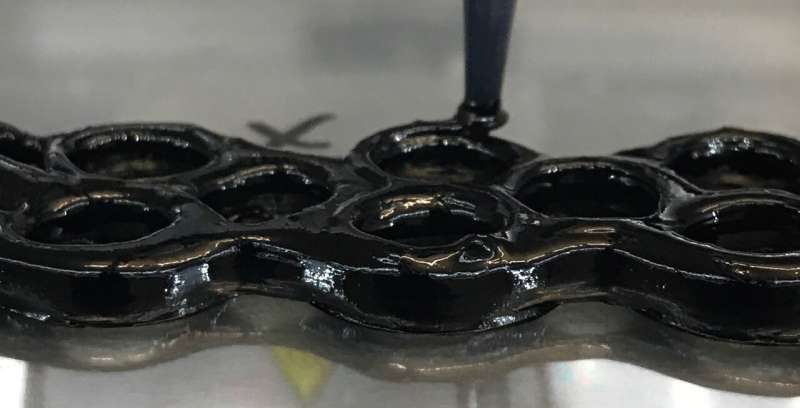This article has been reviewed according to Science X's editorial process and policies. Editors have highlighted the following attributes while ensuring the content's credibility:
fact-checked
trusted source
proofread
Hitting this stretchy, electronic material makes it tougher

Accidents happen every day, and if you drop your smartwatch, or it gets hit really hard, the device probably won't work anymore. But now, researchers report on a soft, flexible material with "adaptive durability," meaning it gets stronger when hit or stretched. The material also conducts electricity, making it ideal for the next generation of wearables or personalized medical sensors.
The researchers will present their results today at the spring meeting of the American Chemical Society (ACS).
Inspiration for the new material came from a mixture commonly used in cooking—a cornstarch slurry.
"When I stir cornstarch and water slowly, the spoon moves easily," explains Yue (Jessica) Wang, a materials scientist and the project's principal investigator. "But if I lift the spoon out and then stab the mixture, the spoon doesn't go back in. It's like stabbing a hard surface." This slurry, which helps thicken stews and sauces, has adaptive durability, shifting from malleable to strong, depending on the force applied. Wang's team set out to mimic this property in a solid conductive material.
Many materials, such as metals, that conduct electricity are hard, stiff or brittle. But researchers have developed ways to make soft and bendable versions using conjugated polymers—long, spaghetti-like molecules that are conductive. Yet, most flexible polymers break apart if they undergo repeated, rapid or large impacts. So, Wang's team at the University of California, Merced, set out to select the right combination of conjugated polymers to create a durable material that would mimic the adaptive behavior of cornstarch particles in water.
Initially, the researchers made an aqueous solution of four polymers: long, spaghetti-like poly(2-acrylamido-2-methylpropanesulfonic acid), shorter polyaniline molecules and a highly conductive combination known as poly(3,4-ethylenedioxythiophene) polystyrene sulfonate (PEDOT:PSS). After spreading a thin layer of the mixture and drying it to make a film, the team tested the stretchy material's mechanical properties.
They found that rather than breaking apart from very rapid impacts, it deformed or stretched out. The faster the impact, the more stretchy and tough the film became. And surprisingly, just a 10% addition of PEDOT:PSS improved both the material's conductivity and adaptive durability. Wang notes that this result was unexpected because on their own, PEDOT and PSS don't get tougher with rapid or high impacts.
The four polymers, two with positive charges and two with negative charges, tangle up like a big bowl of spaghetti and meatballs, explains Di Wu, a postdoctoral researcher in Wang's lab who is presenting the work at the meeting.
"Because the positively charged molecules don't like water, they aggregate into meatball-like microstructures," says Wu. The team's hypothesis is that the adaptive behavior comes from the meatballs absorbing the energy of an impact and flattening when hit, but not completely splitting apart.
However, Wu wanted to see how adding small molecules could create a composite material that was even tougher when stretched or dropped quickly. Because all the polymers had charges, the team chose molecules with positive, negative or neutral charges to test. Then they assessed how the additives modified the polymers' interactions and impacted each material's adaptive durability.
Preliminary results have indicated that the positively charged nanoparticles made of 1,3-propanediamine were the best additive, imparting the most adaptive functionality. Wu says this additive weakened the interactions of the polymers that form the "meatballs," making them easier to push apart and deform when hit, and strengthened the tightly entangled "spaghetti strings."
"Adding the positively charged molecules to our material made it even stronger at higher stretch rates," says Wu.
In the future, Wang says, the team will shift toward demonstrating the applicability of their lightweight conductive material. The possibilities include soft wearables, such as integrated bands and backside sensors for smartwatches, and flexible electronics for health monitoring, such as cardiovascular sensors or continuous glucose monitors.
Additionally, the team formulated a previous version of the adaptive material for 3D printing and produced a replica of a team member's hand, demonstrating the potential incorporation into personalized electronic prosthetics. Wang thinks the new composite version should also be compatible with 3D printing to make whatever shape is desired.
The adaptive durability of the material means that future biosensor devices could be flexible enough for regular, human motion but resist damage if they're accidentally bumped or hit hard, explains Wang. "There are a number of potential applications, and we're excited to see where this new, unconventional property will take us."
Provided by American Chemical Society





















